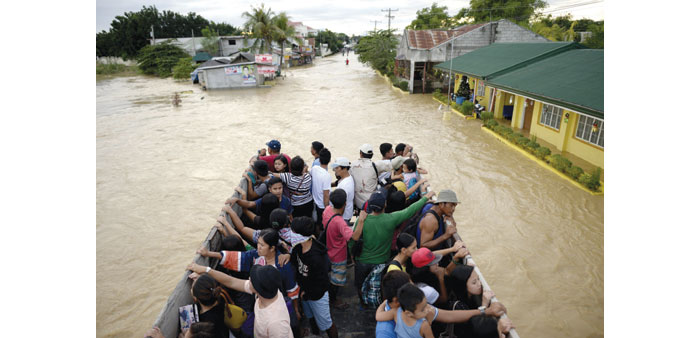Residents ride on a truck over floodwaters to evacuate to higher ground in Candaba, Pampanga, north of Manila yesterday.
AFP
Candaba
Tens of thousands of people struggled yesterday through waist-deep floods in typhoon-battered farmlands near the Philippine capital, as yet another storm threatened to dump more rain.
Large parts of four farming provinces on the main northern island of Luzon have been submerged in water since Wednesday due to Typhoon Melor, which left at least 27 people dead in its wake.
Hundreds of thousands of people there had yet to recover from Typhoon Koppu, which claimed 54 lives while causing flooding that lasted for more than a week and destroyed vast swathes of rice crops just before harvest in October.
President Benigno Aquino yesterday declared a “state of national calamity” to hasten the government response, his spokesman, Herminio Coloma, told reporters.
Truck driver Roberto Mariano, who has been out of work since Koppu, again found the small bungalow he shared with 15 relatives submerged.
“The floods mean no work and no money for me,” the 51-year-old said, trying to keep his balance as he walked through strong flood currents in Candaba, around 50 kilometres north of Manila.
Mariano, who used to earn 500 pesos ($10) driving, was on his way to his parents’ house to borrow money to buy rice.
“It’s very hard out here. I have to go out because we’ve run out of food in the house,” he said.
Mariano said he had spent the last two nights sleepless, anxiously watching as the waters nearly submerged the children’s wooden beds.
Flooding was expected to spread to other parts of the country with a tropical depression, locally dubbed Onyok, on course to hit coastal villages on the main southern island of Mindanao later.
In Surigao del Sur province, where Onyok was expected to make landfall first, authorities prepared for possible evacuation and readied trucks and excavators to clear landslide debris, governor Johnny Pimentel said.
“We are prepared for this storm... the biggest threat here is the floods,” he said.
While Onyok will hit land about 700 kilometres from the farming regions currently enduring floods, it could still bring rain to those areas, said Esperanza Cayanan, a state weather bureau forecaster.
The weather misery comes a week before Christmas, the most celebrated holiday in the predominantly Catholic nation of 100mn people.
“We should not be in holiday mode,” Cayanan told reporters.
In the Candaba town centre, residents with groceries in hand rode small wooden boats and makeshift rafts made from refrigerator doors.
Others showed commitment to their daily routines, eating at roadside canteens waist-deep in flood waters.
“We’re used to this, but it doesn’t make it any less difficult,” said Candelaria Balagtas, a 68-year-old retired policewoman.
The country is ravaged by an average of 20 major storms a year, many of them deadly.
Balagtas said she risked triggering her arthritis by wading through the frigid waters to the market to buy rice and sardines for her daughter after they ran out of food.
“I’m lucky I have my pension, but the people here, their farms were destroyed, the fishermen can’t go out to fish,” she said.
The islands of the Philippines are often the first major landmass that storms hit after they emerge over the Pacific Ocean.
In November 2013, Super Typhoon Haiyan, one of the strongest storms on record, flattened entire communities in poor farming and fishing communities, leaving 7,350 people dead or missing.

